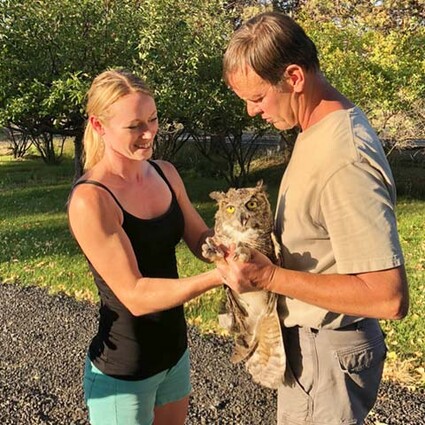Rescuing raptors poses challenges
Last updated 2/19/2020 at Noon

Carol Statton
“Hope” is a great horned owl found injured along Hwy 126 near Cline Falls and who was successfully rescued, rehabilitated and released in 2018.
Life in Central Oregon provides amazing opportunities to observe wildlife on a daily basis. There are many parts of the United States where one would never have the opportunity to see something as magnificent as an eagle, hawk, owl or other member of the raptor family. In Sisters, we share life with these creatures and moments of observation can occur while strolling through a neighborhood, hiking on trails, driving from one location to another or just being home.
Living in close proximity also creates dangers for these birds, as well as the necessity to act on their behalf where one does get injured. Civilization continues to expand into once open and undeveloped spaces, and there are times when our presence in this natural world has unintended impacts.
One morning, just a few weeks ago, an injured great horned owl was spotted along Hwy 126 just outside of Sisters. Possibly hit by a car, it appeared that this owl had sustained a disabling wing injury. Timing is everything when trying to save a life; timing and the ability to keep an eye on where they might move to while help is on the way.
Within a short time after being spotted, a call was made to Gary and Kellie Landers of Wild Wings Raptor Rehabilitation of Central Oregon, located in Sisters.
The Landers respond to calls like this throughout the year, and one of the most critical aspects of a successful rescue is knowing exactly where the bird is. Even when severely injured, a bird (or any other creature) can move a considerable distance and become difficult or impossible to find. Within 15 minutes after receiving the plea for help, Gary arrived and was guided down a driveway and into a distant field surrounded in part by thick trees where the owl could have easily been hidden. He was able to keep the bird under continuous observation and then captured her.
There are many factors in successfully rehabilitating an injured bird: the age and/or severity of the injury being just one part of the complex world of raptor rescue.
Although often appearing deceptively calm while being helped, raptors undergo tremendous stress from human contact, which also affects their potential for recovery.
Possibility for release back into the wild is also important.
Not every rescue attempt leads to the desired outcome, but when given the chance to intervene, every outcome is in the best interest of the bird.
Whether successfully healed and released, or euthanized to end suffering, human intervention at this level is truly an example of what mindful and responsible stewardship can accomplish.
For the great horned owl rescued that day, her story concluded not as hoped for, but with the most compassionate decision made. Just 11 days earlier, another call came in regarding an injured owl in the same general area and Landers responded quickly. During that rescue attempt, the bird could not be watched continuously and despite a lengthy search, could not be located. Most likely, both reports were focused on the same bird and the length of time in between proved insurmountable. After a thorough examination, the injury turned out to be healed past the point of correction. Had she been found sooner, the type of injury sustained could have been successfully treated.
Interestingly, her body condition, although declining, indicated that her mate may have continued to feed her despite her inability to return to the nest.
Somewhere in a nearby tree, this owl’s mate may still wonder where she went. His dedication to caring for her while she was unable to leave the ground displays beautifully how other species share family bonds with strong nurturing instincts.
It can feel daunting to respond to an injured raptor, however we don’t need to have all of the answers or even the professional skills to save a life. Most necessary is the willingness to take that first step, to be willing to stop, to stay and safely keep an eye on the injured bird, to minimize additional stress and to make a call to either a specialist or law enforcement that can respond. At that point there is guidance accessible and directions on how to proceed safely.
Take action:
If you spot an injured raptor, contact Gary and Kellie Landers of Wild Wings Raptor Rehabilitation of Central Oregon at 541-213-4411 or 541-408-0863.
















Reader Comments(0)